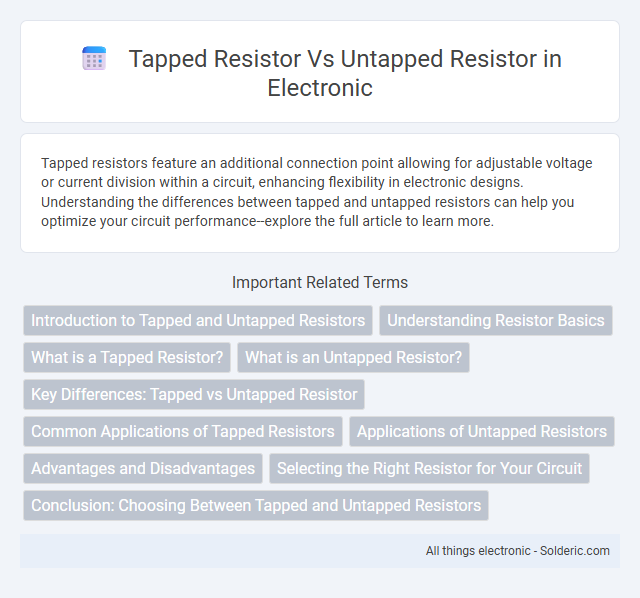Tapped resistors feature an additional connection point allowing for adjustable voltage or current division within a circuit, enhancing flexibility in electronic designs. Understanding the differences between tapped and untapped resistors can help you optimize your circuit performance--explore the full article to learn more.
Comparison Table
| Feature | Tapped Resistor | Untapped Resistor |
|---|---|---|
| Definition | Resistor with one or more intermediate connection points (taps). | Resistor with no intermediate taps; single continuous resistive element. |
| Function | Allows variable or multiple resistance values from a single component. | Provides fixed resistance value. |
| Applications | Voltage dividers, adjustable circuits, multi-tap feedback networks. | Current limiting, biasing, fixed load applications. |
| Complexity | More complex due to extra terminals and connections. | Simpler design with two terminals. |
| Cost | Generally higher due to added manufacturing steps. | Lower cost and easier sourcing. |
| Adjustability | Offers adjustable or selectable resistance values. | Fixed resistance; no adjustability. |
Introduction to Tapped and Untapped Resistors
Tapped resistors feature one or more intermediate connection points along their resistive element, allowing for variable voltage division and enhanced circuit flexibility. Untapped resistors have a single continuous resistive path with two terminals, providing fixed resistance values without intermediate tapping. Tapped resistors are commonly used in applications requiring adjustable voltage levels, while untapped resistors serve as standard fixed resistors in most electronic circuits.
Understanding Resistor Basics
Tapped resistors feature an extra connection point along the resistive element, allowing for multiple resistance values from a single component, while untapped resistors provide a fixed resistance with only two terminals. Understanding how tapped resistors offer adjustable voltage division and flexibility in circuit design can enhance your ability to tailor electrical parameters precisely. Choosing between tapped and untapped resistors depends on whether your project requires fixed resistance or variable control within a compact footprint.
What is a Tapped Resistor?
A tapped resistor is a specialized resistor with one or more intermediate connection points, or "taps," along its resistive element, allowing you to access different voltage levels or resistance values within a single component. This feature makes tapped resistors ideal for applications requiring adjustable voltage dividers or precise feedback control in circuits. Unlike untapped resistors, which offer a fixed resistance between two terminals, tapped resistors provide greater flexibility for customizing voltage and current in your electronic design.
What is an Untapped Resistor?
An untapped resistor is a type of resistor with a single continuous resistive element, providing a fixed resistance value across its two terminals. Unlike tapped resistors, which have additional intermediate connection points to access different resistance levels, untapped resistors maintain consistent resistance throughout. Your circuit design using untapped resistors benefits from simplicity and predictable resistance without variable adjustment options.
Key Differences: Tapped vs Untapped Resistor
Tapped resistors feature an intermediate connection point along their resistive element, allowing for adjustable voltage division and tailored resistance values within a circuit, whereas untapped resistors provide a fixed resistance without any intermediate taps. Tapped resistors are commonly used in applications requiring variable voltage outputs or precise control, such as in voltage dividers and adjustable sensors, while untapped resistors find use in standard current limiting and fixed resistance scenarios. The presence of tap points significantly enhances design flexibility by enabling multiple resistance selections from a single component in tapped resistors, unlike the single resistance value of untapped resistors.
Common Applications of Tapped Resistors
Tapped resistors are widely used in applications requiring multiple voltage levels or adjustable output signals, such as voltage dividers in power supplies, audio equipment tone controls, and feedback circuits in amplifiers. Untapped resistors typically serve in simple current-limiting or voltage-dropping roles where a single resistance value is sufficient, frequently found in LED circuits and basic sensor interfaces. The versatility of tapped resistors in creating precise voltage taps makes them essential in complex electronic devices that demand variable resistance configurations.
Applications of Untapped Resistors
Untapped resistors are widely used in applications requiring simple current limiting, voltage division, or signal conditioning without the need for intermediate access points. Their straightforward design makes them ideal for standard feedback loops, biasing circuits, and power dissipation roles where a single resistance value is sufficient. You will commonly find untapped resistors in consumer electronics, automotive sensors, and basic analog circuits where ease of use and reliability are paramount.
Advantages and Disadvantages
Tapped resistors offer precise voltage division and allow fine adjustment in circuits, making them ideal for calibration and feedback applications. However, they are generally more complex and costly compared to untapped resistors, which provide simple, stable resistance without adjustment options. Your choice depends on whether adjustability or simplicity is more critical for your project's needs.
Selecting the Right Resistor for Your Circuit
Tapped resistors offer adjustable resistance points within a single component, enabling fine-tuning of voltage or current levels in complex circuits. Untapped resistors provide fixed resistance, ensuring stable and predictable performance ideal for simple, consistent applications. Selecting the right resistor depends on the circuit's need for variability, precision, and space constraints, with tapped resistors favored in adjustable settings and untapped resistors suited for straightforward resistance requirements.
Conclusion: Choosing Between Tapped and Untapped Resistors
Tapped resistors offer adjustable voltage division points, providing flexibility in circuit design and fine-tuning applications where precise voltage control is required. Untapped resistors provide a fixed resistance value with simplicity and reliability, ideal for straightforward circuits with stable parameters. Your choice depends on whether your application prioritizes customizable voltage levels or consistent, unchanging resistance performance.
tapped resistor vs untapped resistor Infographic

 solderic.com
solderic.com